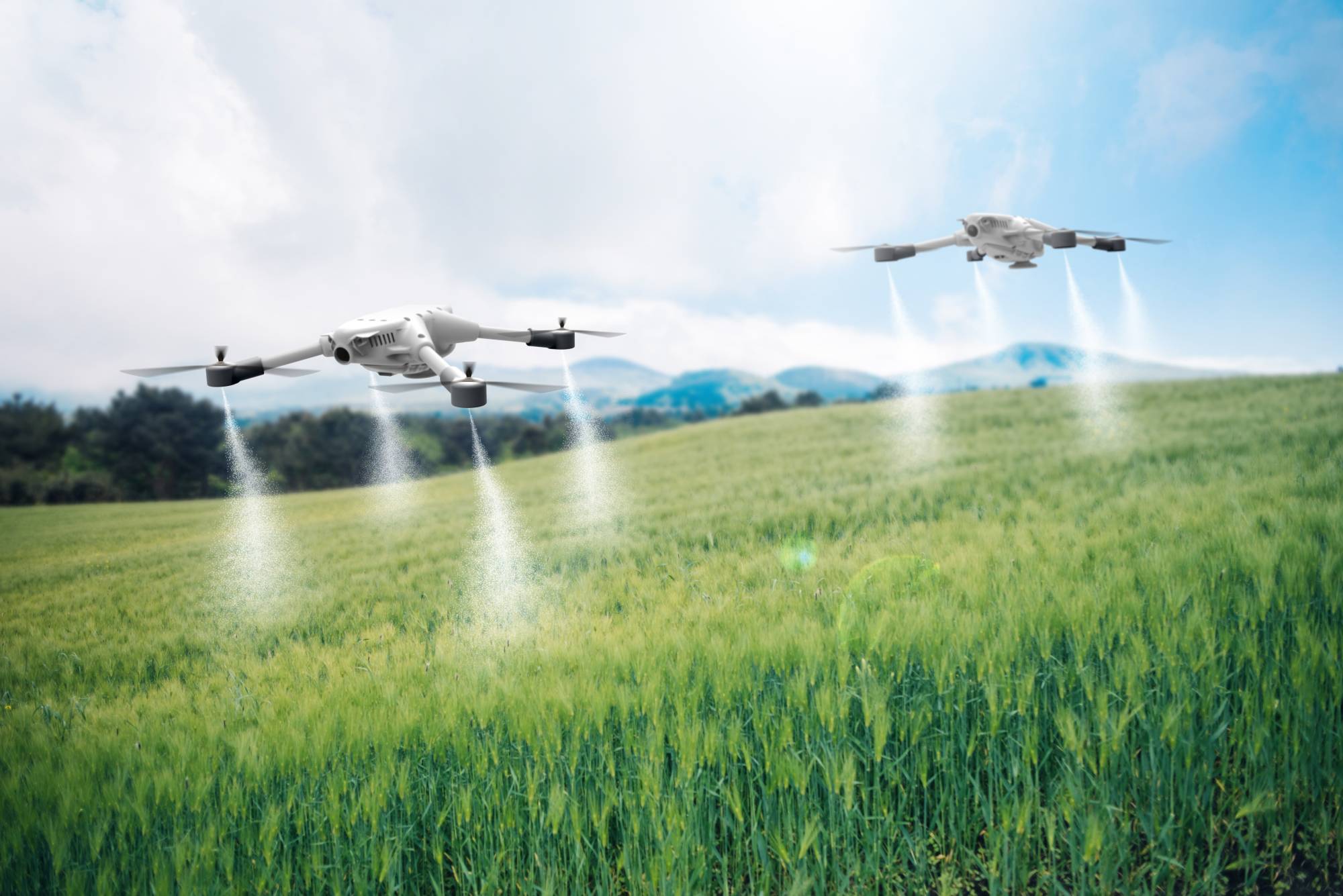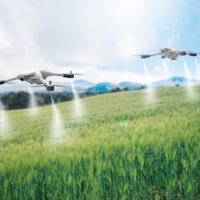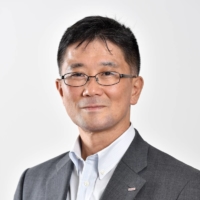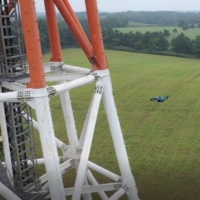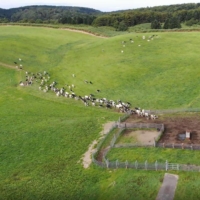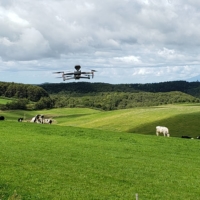DRONE FUND, established by Kotaro Chiba in 2017, has provided capital to help develop the drone business. It launched the third round of funding to accelerate social implementation of drones and air mobility in May, aiming to raise ¥10 billion. NTT DOCOMO INC. is one of the first companies to invest in the fund.
Soki Ohmae, co-founder and managing partner of DRONE FUND and Hisakazu Tsuboya, executive operating officer and general manager of 5G & IoT Business Department of NTT DOCOMO, discuss how drones and the air mobility business have developed and how 5G technology helps improve drone usability.
The Japan Times (JT): DRONE FUND is a self-described venture capital fund that aims for the realization of a “drone and air mobility-based society.” What is this society like?

Ohmae: This interview is being conducted online, and everybody here is using the internet at the same time. What makes it possible is the infrastructure built by NTT DOCOMO and other companies. The general public can now use the internet without thinking much about it. People can no longer imagine their lives without it. That’s what we call the internet-based society. Likewise, with the “drone and air mobility-based society” we are trying to create the coming age in which drones, air mobility and aero products are an essential part of human society, just like the internet. So we set the goal of realizing this as our philosophy. This isn’t science fiction. Society hasn’t used much of the space between the ground and the altitude of about 300 meters. So our basic philosophy is that society should definitely take advantage of this space.
JT: Can you tell us about the drone business NTT DOCOMO has operated so far?
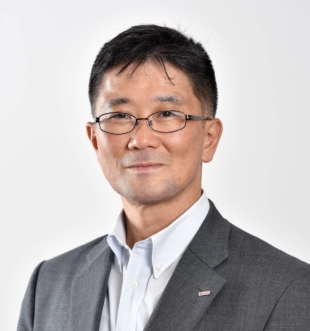
Tsuboya: We also have been interested in the drone and air mobility-inspired world view. Our plan is to add a platform called docomo sky to the existing activity and grow this business in three directions. First, docomo sky provides comprehensive support for work flow. We have nearly 200,000 base stations across Japan. These are devices that send radio waves for mobile phones. We are actually using drones to inspect them. So we wanted to develop a platform for this purpose, as well as management of the craft, and are now trying to use it for other parts of social infrastructure. Secondly, as the drone business grows, drones will eventually shift from flying “beyond the visual line of sight in less-populated areas” to flying “beyond the visual line of sight in populated areas.” So we are going to go from “level 2” to “levels 3 and 4” (in the “2019 road map for industrial revolution in the sky” by the Ministry of Economy, Trade and Industry). That’s when mobile communication technology will become essential for drones. For that, you need to take measures to allow their use of the airspace. Lastly, what’s going on with drones is not just how to fly them or how to control them using the communications infrastructure. There are efforts going in the world to provide support with them in disasters and medical emergencies and even to transport people on them. We definitely want to participate in such drone-using projects as part of our business.
JT: What is DRONE FUND’s third fund all about, and what was the biggest reason NTT DOCOMO decided to invest in it?
Ohmae: We completed the first fund in 2018 and the second in 2019. The first raised ¥1.59 billion and the second fund raised ¥5.2 billion from investors. When we launched the first fund, drones weren’t very well known and there weren’t many investors. We launched the second fund a little later, and we were able to attract investors who wanted to get involved in promising projects. I think the third fund is coming at a time when the widespread introduction of drones is expected. Our focus for the third fund is how the aero industry can be better understood by the general public and whether it can develop to where drones can be utilized widely as a part of infrastructure. We’re now in a phase in which a new industry will take shape as a large number of products play complex roles, not just the question of how one may be able to promote acceptance of drones or introduce a single product.
Tsuboya: So far, we have focused on flying and operating drones, but more recently, we have been thinking more about how we may go about promoting the acceptance of drones in society. We need to prepare wide-ranging assets and partnerships for operating the moving objects in a business environment in the sky where we have no experience.
JT: To what extent have drones been introduced? In what areas are they used?
Ohmae: Japan’s infrastructure is at a rather advanced stage of aging. We need to conduct inspections on infrastructure items to find out if we can continue to use them, if they need servicing, or if we need to suspend their use to conduct major repair work. As the people engaging in inspection work are decreasing in number, there is possibility some bridges or roads may become unusable if the situation remains unaddressed. Helping get such work done smoothly and quickly is what people want drones to do in the area of inspections and servicing.
Tsuboya: Antennas that supply radio waves to mobile phones often use high steel towers so that they can cover wide areas. Those set up in areas near sea coasts can become rusty, which is a major issue in infrastructure maintenance. Last year, in-house engineers used drones to inspect 1,000 base stations and collect data. We regard these engineers as essential resources and assets.
Ohmae: The high potential of drones to help conduct research and analysis to solve issues and collect information is attracting attention as their important functions. If people use static cameras, they can observe static objects, but drones are more flexible, as they can fly. With drones, people can capture 3D objects in three dimensions, and create sets of data comprised of 3D information. When you have accumulated data, you can speed up the process of finding problems using the methodology of differential data. Additionally, when combined with artificial intelligence to recognize problems, it becomes easier to assess the extent of the problem or how much it may deteriorate based on the differential data. By combining drones and artificial intelligence , people can create an environment that facilitates solving of problems, including predicting when a problem may occur more accurately than humans. This is the role of drones as remote sensors.
Apart from this, drones have the role as field robots. These are robots that do work in place of people. Farming is one example where there is a great deal of hard work. When spraying agricultural chemicals or conducting work covering a wide area, people typically use farming equipment that moves on the ground. Drones are an effective way to expand the area of such work and increase efficiency. To cite an example of the most advanced practice, a Hokkaido rice farmer sows seeds using drones, and when they sprout, their growth is monitored using data from sensors on the drones. From what I hear from a farmer acquaintance, his work efficiency has improved by about 50%. Japanese farmers have to maintain productivity even as the country’s population decreases, and using robots is a very important solution for issues like this.
Tsuboya: We support efforts to utilize drones for industrial purposes as a result of working with different partners. At a project at a Hokkaido dairy farm, a team of ours conducted a proof of concept test. One of the duties they do after they release cows in the field is herding cows. That’s when the farmer, or dogs, herd the cows back into the barn. This can actually be done by playing a type of sound to a herd of cows. When we tried this method using drones, we were able to complete the work, which used to take several hours, in just 15minutes.
Ohmae: At SkyDrive Inc., one of our investee companies, the heaviest load a drone can carry is about 30 kilograms. Typically, drones used to spray chemicals are those that can carry at least 10 kilograms.
Tsuboya: As we are aiming to create an environment using the mobile communication infrastructure, communication can be established if drones are designed to be communication-ready, basically, in the same way as mobile phones. If the area is optimized, a drone can technically fly a long distance.
Ohmae: Drones can fly where there is a 4G or 5G connection.
Tsuboya: We hope to create an environment where drones can fly beyond the visual line of sight continuously, as long as batteries last.
Ohmae: Under the current Japanese law, drones can fly only up to 150 meters above the ground. It’s difficult to have an object flying in the sky carry mobile phone signals under Japanese law, as special permission is required. However, as promoting an industrial revolution in the sky is a key goal for the government, it may eventually become more flexible.
JT: How have drones been used amid the global spread of the coronavirus? And how has it impacted acceptance of drones?
Ohmae: I can say people have grown more receptive of drones. The coronavirus has forced society to reduce labor. For example, cleaning work at certain facilities may expose workers to the risk of infection. In such a case, people now naturally think of using not just drones, but also robots to solve the situation. Transportation of things in mountainous areas or isthmuses is another example. A key problem for the transportation industry is a shrinking workforce. If you want to maintain service in such a situation, introducing robots is an urgent task, in my view. There are accelerating moves to solve such situations quickly, and this has helped link problems with technology. There are many examples. One is the use of drones designed to spray farm chemicals to spray an antiseptic solution. I think such an application is an example of growing moves to solve problems by using existing technologies.
Tsuboya: Drones are used where there are restrictions on human activity. It’ll be great if we can help conduct work in places where there are restrictions, like, eliminating the need to use human workers in risky work in high places or taking pictures from the sky in areas where people cannot reach after a natural disaster. The coronavirus has caused our society to quickly shift to a remote society. The acceptance of drones has reached a higher level than ever.
JT: What kind of innovations will a greater use of 5G mobile technology bring about for drones and air mobility?
Tsuboya: 5G is a communication technology. The key is how you use it. Unlike LTE, in which sensor data — mainly binary data — was transmitted, it’s clear that 5G’s transmission technology was developed with video in mind. It’s a network used to quickly analyze high-definition videos using AI and spit out the results. Using it, drones can fly using the visual SLAM (simultaneous localization and mapping) technology and images that makes them aware of the shape of the space surrounding them. Drones also capture video and send it to the computer cloud. For a process like this, 5G is totally different from the fourth generation, and it is very compatible. The key is for drones to use video. This is utilized in farming and construction work, so high-definition video will be used in these areas.
Ohmae: Currently, the pilot must be on-site to operate a drone using flight control or ground control systems. In this scenario, the pilot operates a drone on a one-on-one basis, and the pilot has the sole responsibility for any trouble that may happen. We think this relationship will shift to one-to-multiple drones in the future. In other words, a single, highly skilled pilot will carry out work by monitoring multiple drones that behave autonomously and automatically. If this isn’t possible, there can’t be society where 1 million, or even 2 million, drones and robots serve. If 1 million robots require 1 million pilots, then you’ll have to make everybody a pilot. I think we will eventually have to have solo pilots operate 100, 200 or even 1,000 robots. When that time comes, latency will become an issue. If multiple pilots gather at a place from where they operate robots and there is latency and communication between the pilots and the robots is slow, a delay of just one or two seconds could lead to a serious accident. The 5G society can solve such a problem. When you try to communicate with 1 million to 2 million robots, 4G or LTE can’t handle it all. Humans are also using the network, so the network would be overloaded. Creating an infrastructure where Internet of Things (IoT) devices can directly connect to networks is a task of utmost importance.
Tsuboya: The current market for IoT devices is still only around several tens of million units, but it has the potential to grow to a several billion units market. It is a critical mission for us, as a telecommunication carrier, to build a network that allows many IoT devices to simultaneously collect information and large amounts of data to be processed such as supporting the realization of self-driving cars and remote medical care.
Ohmae: Self-driving technology may eventually produce cars without a steering wheel. There’s possibility that a car may be operating with none of its passengers knowing how to drive. In such a case, a separate operator in a separate location will take that role. We have to have that sort of situation in mind. What will support this is communication, so communication speed must be fast. Safe driving requires huge amounts of information, especially image information. It will require far greater technological advancement to achieve this.
JT: What are the hurdles that must be overcome for drone businesses to grow further?
Ohmae: There are many issues. The government has worked out road maps for a program to support the development of the aero industry. There are two key road maps. One is for what it calls an industrial revolution in the sky and the other is for a mobility revolution. In recent years, there have been more active moves seeking to relax the level-3 and level-4 restrictions in the road map for the industrial revolution in the sky. Under level 3, drones are flown beyond the visual line of sight in less-populated areas. In a level-3 flight, the drone can go to places where the operator can’t see it. The drone is allowed to fly over areas where there is no concentrated population, without flying over the general public. Under level 4, they can fly over areas where population is concentrated. When this happens, the question is how to set the standards for safe operation, craft performance and assessment. As multiple drones will fly in the same areas, operational control systems will have to recognize each other’s presence and communicate with each other on when and where their drones are flying. The situation where we stand is, we’ll need to solve an issue like this before the target date, which is in just two years.
Tsuboya: When you fly a drone beyond the visual line of sight, the drone is connected to the operator through a communication network, just like mobile phones, to be controlled. We are now on the verge of seeing deregulation to allow connecting drones flying in the sky through radio or mobile communication networks. If someone tries to start a new business, they have various regulatory restrictions to overcome before they can fly an aircraft in the first place. Drones are basically lightweight, even those weighing several tens of kilograms. They may not be able to fly, or may be banned from flying, depending on weather or wind conditions.
Ohmae: I think we must introduce a type of information control that is different from what has existed, on flying drones or a plan that allows autonomous robots to make decisions on their own. In existing aircraft, pilots are always in them and are responsible for making final decisions. Aircraft have various onboard devices, including those indicating weather conditions. Even if an aircraft becomes completely offline, its pilot is trained to land it one way or other. However, it’s very difficult for a drone, which is a robot, to do this. To make a drone do this, there is a need to design everything.
For example, if people are to operate drones over a long distance safely, they must be predesigned to make the optimum judgment in a situation where it is pushed by a sudden strong gust of wind in flight. Drones are vulnerable to swirling winds, which often occur in mountainous areas, so it will have to be able to alter its flight path to avoid them. Unless drones themselves are equipped to learn the wind conditions in real time and find specific solutions, they cannot manage their safe operation or operate over long distances.
In terms of law, drones must not fly higher than 150 meters from the ground under the regulations of the Civil Aeronautics Act. There is a space that is not used to ensure the safety of aircraft, and it is about 500 meters from the ground. Under Japan’s civil law, a landowner’s right to a piece of land is set to extend up to 300 meters above. In terms of law, multiple laws run against each other in places. Unless we solve these issues, use of the sky can’t grow. Furthermore, there’ll be people who will want to fly unmanned aircraft in areas 1,000 meters to 2,000 meters above the ground, where manned aircraft also are flying. To allow them to operate simultaneously, we have to reform related laws.
There are many legal issues that are yet to be resolved that involve unmanned aircraft, drones, and use of the airspace above landowners. We need to sort out and solve these issues in ways that will be beneficial to people and Japan.
This page has been produced with the support of the Ogasawara Toshiaki Memorial Foundation for the Promotion of Science and Engineering, which was founded by late Toshiaki Ogasawara, the former chairman and publisher of The Japan Times.



